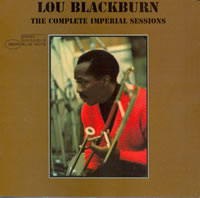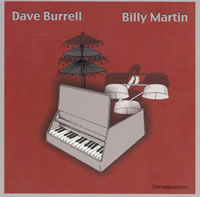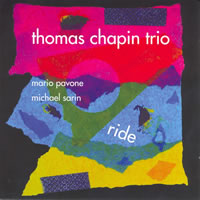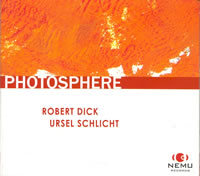Moment's Notice
Recent CDs Briefly Reviewed
by
Bill Shoemaker
Lou Blackburn
The Complete Imperial Sessions
Blue Note 0946 3 58294 2 6
 Lou Blackburn was only in LA for ten years beginning in 1961, making ends meet through studio work much of the time. Though this base of operations afforded such noteworthy opportunities as performing “Meditations on Integration” with Mingus at Monterey, the fact remains that Blackburn remains a rarely remembered figure. He doesn’t even make the index of Steven Isoardi’s The Dark Tree: Jazz and the Community Arts in Los Angeles (University of California Press), despite the forceful presence of pianist Horace Tapscott in the quintet Blackburn co-led with trumpeter Freddie Hill. It is their two albums recorded under Blackburn’s name in early 1963 that comprise The Complete Imperial Sessions. Hearing a pre-UGMAA Tapscott pivot from asymmetrical lines and a jabbing attack to a graceful swinging of 3/4 time on 19 tracks – everything from potentially sappy standards like “Secret Love” to a slew of well-crafted Blackburn originals – is certainly sufficient reason to check out the collection.
Lou Blackburn was only in LA for ten years beginning in 1961, making ends meet through studio work much of the time. Though this base of operations afforded such noteworthy opportunities as performing “Meditations on Integration” with Mingus at Monterey, the fact remains that Blackburn remains a rarely remembered figure. He doesn’t even make the index of Steven Isoardi’s The Dark Tree: Jazz and the Community Arts in Los Angeles (University of California Press), despite the forceful presence of pianist Horace Tapscott in the quintet Blackburn co-led with trumpeter Freddie Hill. It is their two albums recorded under Blackburn’s name in early 1963 that comprise The Complete Imperial Sessions. Hearing a pre-UGMAA Tapscott pivot from asymmetrical lines and a jabbing attack to a graceful swinging of 3/4 time on 19 tracks – everything from potentially sappy standards like “Secret Love” to a slew of well-crafted Blackburn originals – is certainly sufficient reason to check out the collection.
Beyond that, however, the collection provides a well-detailed snapshot of pre-Watts Riots jazz in LA’s African American community. These are musicians with one eye on the “New Frontier” (to use a Blackburn title that mixes a hard bop groove and slightly unusual changes, and features a Tapscott solo brimming with ideas he would hone over the following quarter-century). But, Blackburn also kept close tabs on current trends, like the emergent fascination with Brazilian music. And, playing pretty for the people was not an issue, as evidenced by their lustrous takes on tunes like “I Cover the Waterfront” and “Stella by Starlight.” Without a fine set of complementary voices within the quintet, this could be mealy fare. Hill is a bit bolder and saucier than Blackburn, but by no means fiery. The trombonist gets deep in the pocket, but enunciates with pinpoint precision. And, the teamwork of bassist John Duke and drummer Leroy Henderson keeps the solid time that allows Tapscott the occasional oddly shaped phrase or offsetting chord placement. The rapport works hand in glove with the repertoire, which is why this is a rewarding reissue.
Dave Burrell + Billy Martin
Consequences
Amulet amt 022
 Though pianist Dave Burrell has always been associated with The New Thing through his work with Archie Shepp and others, he has nevertheless incorporated his interests in early-century piano styles into his recordings. It is difficult to mesh the two strains seamlessly, and on recent recordings like the fine 2004 Expansions (High Two), Burrell hasn’t tried, deciding instead to dip into Fire Music intensity sparingly between forays into ragtime and stride. Listeners nostalgic for the bristling energy of Burrell albums like 1970’s After Love, which was part of the celebrated 2004 American reissue series, may well find Consequences to be his most satisfying album in many years.
Though pianist Dave Burrell has always been associated with The New Thing through his work with Archie Shepp and others, he has nevertheless incorporated his interests in early-century piano styles into his recordings. It is difficult to mesh the two strains seamlessly, and on recent recordings like the fine 2004 Expansions (High Two), Burrell hasn’t tried, deciding instead to dip into Fire Music intensity sparingly between forays into ragtime and stride. Listeners nostalgic for the bristling energy of Burrell albums like 1970’s After Love, which was part of the celebrated 2004 American reissue series, may well find Consequences to be his most satisfying album in many years.
Some may initially think Modeski, Martin & Wood drummer Billy Martin is an unlikely magneto for the resurgence of this facet of Burrell’s playing, but Martin quickly establishes an emphatic approach. Martin does not simply mirror Burrell’s every move; rather, he initially sets his own tack, remaining roughly parallel to Burrell’s shifts in dynamics and attack. It’s an approach that is sufficiently flexible to fully respond Burrell’s every move. Even when Burrell is at his most furious, he is a keen listener, and can make avalanches turn on a dime, or abruptly stop altogether. Conversely, Burrell can take a device as simple as a repeated note and quickly take it to any number of directions, depending on what he’s hearing from his counterparts.
Four of the five tracks clock in between 9 and 11 minutes, ample time for Burrell and Martin to explore several spaces. Burrell has long demonstrated an uncanny sense of timing in freely improvised pieces, a sixth sense of knowing when to initiate a high-contrast transition. Martin is equally effective at unleashing the furies as he is at feathering the colors. And, what works well within the ten-minute timeframe works just as well on the 18 1/2-minute “Monsoon.” It’s a real collaboration.
Thomas Chapin Trio
Ride
Playscape PSR#071595
 Thomas Chapin’s legacy can be roughly divided into two parts, one of which, to use the parlance of jazz funding institutions, is outreach. At a time when considerable institutional efforts were directed towards a largely elusive youth audience, Chapin went under the radar and energized an audience of university students and twentysomethings who would otherwise find jazz irrelevant. When the corporate image of jazz was young men in suits playing music dating from way before their births, the pony-tailed, peasant shirted Chapin won over rock-weaned listeners with original music that validated their impulse to shout and pump their fists in the air. In doing so, Chapin cleared the way for Ken Vandermark and others to reach the alt demographic.
Thomas Chapin’s legacy can be roughly divided into two parts, one of which, to use the parlance of jazz funding institutions, is outreach. At a time when considerable institutional efforts were directed towards a largely elusive youth audience, Chapin went under the radar and energized an audience of university students and twentysomethings who would otherwise find jazz irrelevant. When the corporate image of jazz was young men in suits playing music dating from way before their births, the pony-tailed, peasant shirted Chapin won over rock-weaned listeners with original music that validated their impulse to shout and pump their fists in the air. In doing so, Chapin cleared the way for Ken Vandermark and others to reach the alt demographic.
This is part and parcel of the other part of Chapin’s legacy, which is, of course, his music. The connections between the two are best felt on live recordings like Ride. This 1995 North Sea Jazz Festival set with bassist Mario Pavone and drummer Michael Sarin is an excellent example of how Chapin distilled the blues and roots of Mingus, the spirit-talk of Rahsaan and the expansiveness of John Handy’s breakthrough quintet into his music. Most of the pieces have appeared on other Chapin Trio albums, including the luminous flute feature “Aeolus,” the careening “Changes Two Tires,” and Chapin’s signature throw-down, “Amina,” making this a fine introductory album. Still, hardcore Chapin fans will want to check out two previously unreleased pieces, Chapin’s “Pet Scorpion,” which was stuffed with stop-start, push-pull, madly swinging tensions, and his hard-hitting arrangement of the Beatles’ “Ticket To Ride.”
Throughout the set, the interplay between Chapin, Pavone and Sarin is at its inspired best. When musicians of Pavone’s caliber look back a decade and say a particular concert was the zenith, believe him.
Elton Dean + Paul Dunmall + Paul Rogers + Tony Levin
Elton
Duns Limited Editions DLE 051
Mujician
There’s No Going Back Now
Cuneiform Rune 232
 With the passing of saxophonist Elton Dean, pianist Keith Tippett is the only active member of what British jazz historian John Wickes calls the “Tippett/Dean/Osborne axis of UK free jazz” of the 1970s. Any detailed discussion of Dean and Tippett’s activities during the past twenty years must include saxophonist Paul Dunmall, bassist Paul Rogers and drummer Tony Levin, who were members of Dean’s ‘90s quintet and joined with Tippett in the late ‘80s to form the ongoing Mujician. Respectively, Elton and There’s No Going Back Now document how integral Dunmall, Rogers and Levin have been to Dean and Tippett’s sustained creativity.
With the passing of saxophonist Elton Dean, pianist Keith Tippett is the only active member of what British jazz historian John Wickes calls the “Tippett/Dean/Osborne axis of UK free jazz” of the 1970s. Any detailed discussion of Dean and Tippett’s activities during the past twenty years must include saxophonist Paul Dunmall, bassist Paul Rogers and drummer Tony Levin, who were members of Dean’s ‘90s quintet and joined with Tippett in the late ‘80s to form the ongoing Mujician. Respectively, Elton and There’s No Going Back Now document how integral Dunmall, Rogers and Levin have been to Dean and Tippett’s sustained creativity.
Elton documents a 1997 gig at London’s Vortex. It was recorded on cassette from the house, suggesting a rather low-key gathering of friends. This is reinforced by the fade-up for the 40-minute “Two and eleven” and the tuning and waiting that precedes the equally freewheeling “Eeedy Peedy,” the 25-minute closer. Though Rogers is a bit submerged in the more vigorous passages, the overall sound quality is adequate. However, there’s nothing casual about these blows. It is easy to imagine Dunmall coming across the tape after Dean’s death, rediscovering the evening’s many voltage spikes, and deciding on the spot to put it out. Elton is a fitting tribute to a working musician, an improviser who worked without a net.
In terms of production values, There’s No Going Back Now provides a stark contrast to Elton, as it was recorded in a pristine performance space with a brilliant piano, and expertly engineered and mixed. Mujician also has a more formal bearing, due in large part to Tippett, whose crisp attack tends to give the ensembles neat edges, and whose solos inevitably have a well-rounded shape to them. Whereas “Two and eleven” comes across as an inspired ramble through different intensity levels and rhythmic feels, the 45-minute “There’s No Going Back Now” seems designed by comparison. This is not to suggest Mujician overtly plotted the performance, but that nearly twenty years of collaboration have refined their interactions to the point where their improvisations have an intrinsic coherence.
Regardless of the setting, Dunmall, Rogers and Levin leave it all on the bandstand each time out. That’s the case with these two distinctive recordings, and that’s why the history needs to be amended to give them their due sooner rather than later.
Robert Dick + Ursel Schlicht
Photosphere
Nemu 002
 Robert Dick is a true revolutionary who has retooled both the flute and flute technique for the 21st Century. He invented the Glissando Headjoint, which can be roughly compared to a whammy bar on an electric guitar, and has also designed bass flutes renowned for their rich tone and unusual power. For the contemporary flutist, his books on extended techniques are indispensable. Yet, for someone who incorporates so much innovation into his art, Dick’s music is, for the most part, readily accessible. That’s the case with Photosphere, a thoroughly engaging set of duos with pianist Ursel Schlicht. This is a well sequenced program, beginning with Dick’s “Lapis Blues, “ a limpid melody that creates intersecting ripples of timbres from Dick’s Glissando Headjointed flute and Schlicht’s prepared piano. A freely improvised piece built upon languid bass flute and dampened piano phrases, “Emergence” gathers steam without bleeding the duo’s subtle colors into a muddled mass. Schlicht’s compositional chops are well-represented by “Faust,” which juxtaposes angular lines with contrasting rhythmic feels, and the incisive, aptly titled “Fragments.” “Piece in Gamelan Style," a tour de force Dick solo, is inserted between the two Schlicht pieces. Having worked with dancers and silent films, Schlicht know how to make substantive statements that favor clarity over density, making her a fine foil for Dick.
Robert Dick is a true revolutionary who has retooled both the flute and flute technique for the 21st Century. He invented the Glissando Headjoint, which can be roughly compared to a whammy bar on an electric guitar, and has also designed bass flutes renowned for their rich tone and unusual power. For the contemporary flutist, his books on extended techniques are indispensable. Yet, for someone who incorporates so much innovation into his art, Dick’s music is, for the most part, readily accessible. That’s the case with Photosphere, a thoroughly engaging set of duos with pianist Ursel Schlicht. This is a well sequenced program, beginning with Dick’s “Lapis Blues, “ a limpid melody that creates intersecting ripples of timbres from Dick’s Glissando Headjointed flute and Schlicht’s prepared piano. A freely improvised piece built upon languid bass flute and dampened piano phrases, “Emergence” gathers steam without bleeding the duo’s subtle colors into a muddled mass. Schlicht’s compositional chops are well-represented by “Faust,” which juxtaposes angular lines with contrasting rhythmic feels, and the incisive, aptly titled “Fragments.” “Piece in Gamelan Style," a tour de force Dick solo, is inserted between the two Schlicht pieces. Having worked with dancers and silent films, Schlicht know how to make substantive statements that favor clarity over density, making her a fine foil for Dick.
